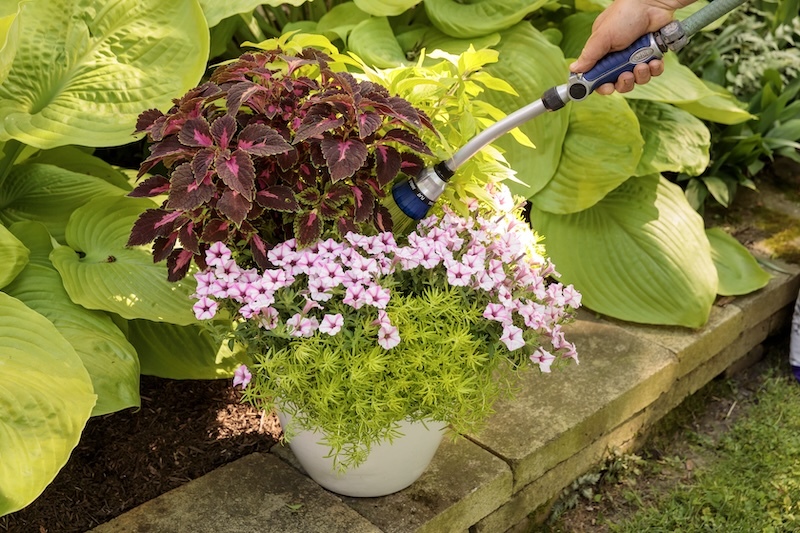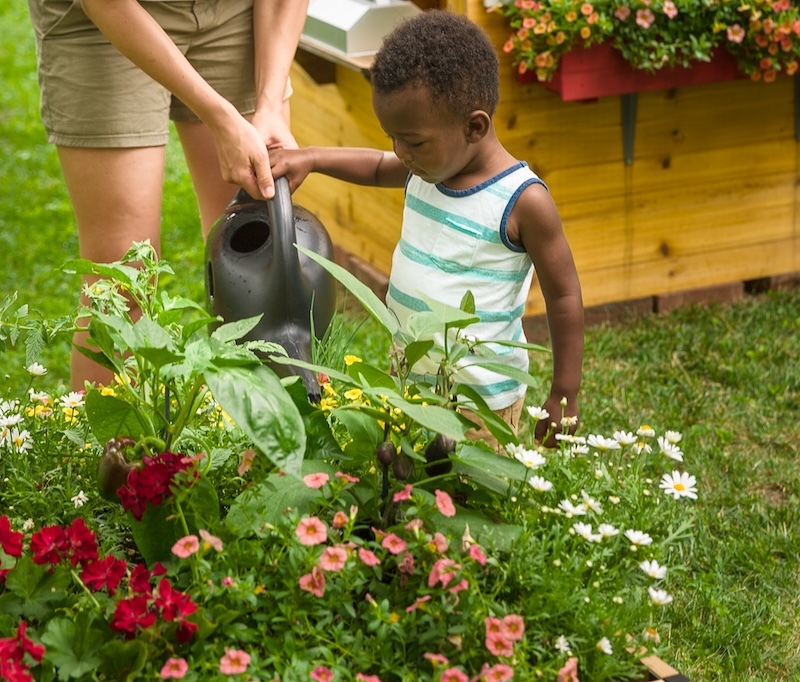In a garden bed, plants can spread their roots as far and wide as they seek out nutrients and water in the soil. Plants in a container, on the other hand, rely on gardeners to supply sufficient water to meet their needs throughout the growing season. The roots of plants in containers are more likely to be exposed to dry conditions, extremes of heat, or overwatering. Read on to learn about our best tips for watering plants in containers.

How Do I Know My Potted Plants Need Watering
Some plants show the effects of dry soil very quickly, while others tolerate periods of dryness or do not show visible symptoms of dehydration. The best way to tell if plants need watering is to touch the soil. Plants that appreciate consistently moist soil will only tolerate the top 1-2 inches of potting mix drying out. This is usually around the second knuckle of your pointer finger when you stick it in the soil. This method is especially useful for large planters that are not easy to move.
The dryness of smaller pots and hanging baskets can be judged by how heavy they feel. In general, a pot that feels heavy for its size contains sufficient moisture. Baskets and pots that are very light and easily lifted should be watered as soon as possible, even if the plants appear to be fine.
How Often to Water Potted Plants
Containers outdoors often require daily checks for watering, especially on hot days. If the container is in a windy location or the plants have reached their mature size, you may also need to check the moisture levels more frequently. Smaller pots may require watering twice a day in the heat of summer. During the cooler temperatures of spring and fall, most containers will only need watering 2-3 times a week. In the winter, potted trees and shrubs will need supplemental watering when temperatures are over 45 degrees F (7 C), especially during dry spells.
Overwatering can be a concern for plants growing in containers without sufficient drainage or in potting soil that stays waterlogged. Adding drainage can be as easy as lifting the pot off the ground slightly with dedicated ‘pot feet’ or three bricks placed firmly under the container. For plants that are sitting in overly wet soil, repotting the plant into a loose potting mix is usually the best option. Pay attention to where the pot sits in relation to gutters and downspouts during heavy rains.

How Much Water to Use
The best adage for containers is to water until excess liquid runs from the bottom of the pot. This method ensures that the soil in an outdoor container is thoroughly saturated. After you let the pot drain for a few minutes, give it another soak to make sure no dry spots in the soil remain.
When a pot is left to dry so long that the soil starts to pull away from the sides or has a crusty layer on top, special care will be needed to fully rehydrate the soil. Dehydrated soil particles allow water to wash over the surface without absorbing any of the moisture. To remedy dry soil, set a hose on a slow trickle to slowly water and fully wet the soil. Small pots can be placed inside of a deep basin or larger bucket filled with water to soak up moisture from the bottom. Two to three short watering sessions over the course of a day is also a good way to rehydrate the soil.
Best Way to Water Potted Plants
Watering during the coolest part of the day, either early in the morning or late in the afternoon, helps to reduce evaporation from the soil and revives heat-weary plants. Water the soil directly and avoid splashing the flowers and foliage, which are more susceptible to mildew and fungal diseases in mixed planters. Use the soft shower setting on a hose-end sprayer to gently deliver the right amount of water without disturbing the soil or plants. You can also set up a drip irrigation system in container gardens, making watering as easy as setting a timer or turning on the outside water tap to water many pots at a time.
Planter Watering Tips
- Add extra air circulation to a pot by rising it off the ground with bricks, pavers or pot feet
- Small pots dry at a much faster rate than large planters, no matter the season or weather
- Windy conditions often dry plants out faster than hot weather
- High humidity or cool weather allows soil to hold moisture longer, reducing the need for supplemental watering
 |
Author Robbin Small - Published 4-13-2024 |
